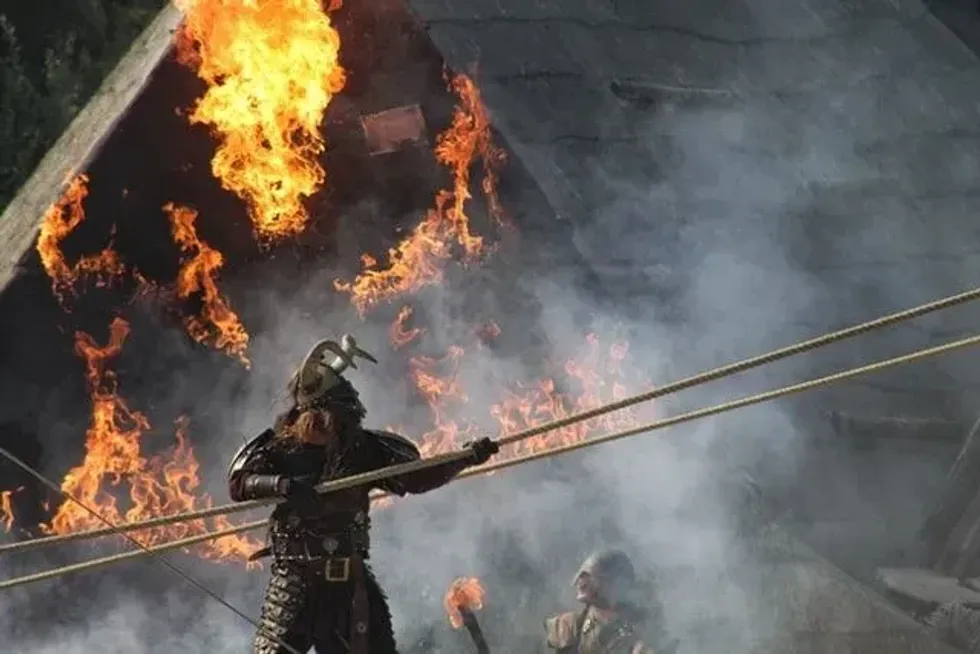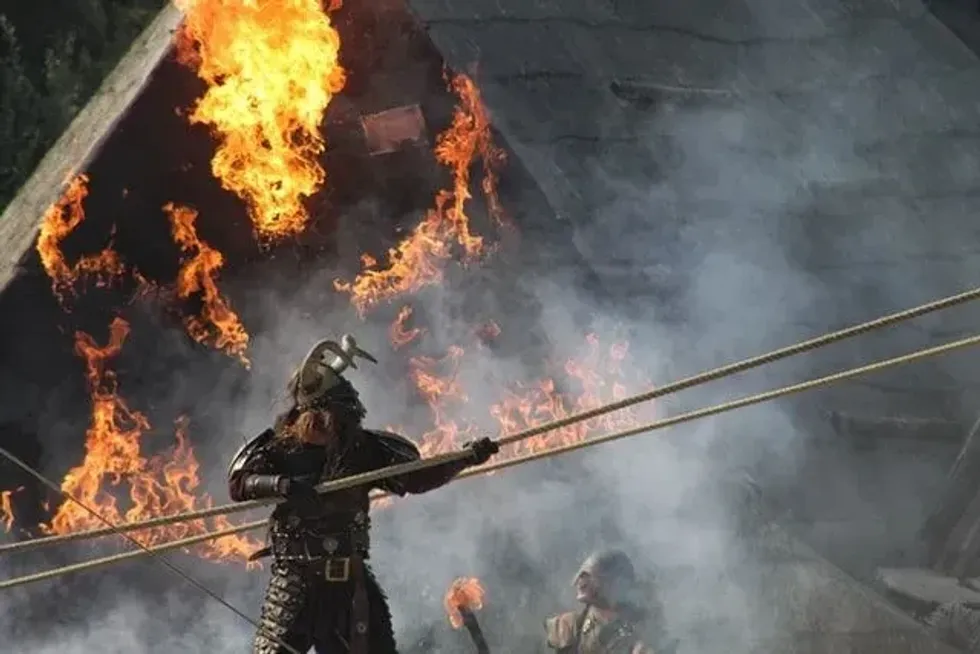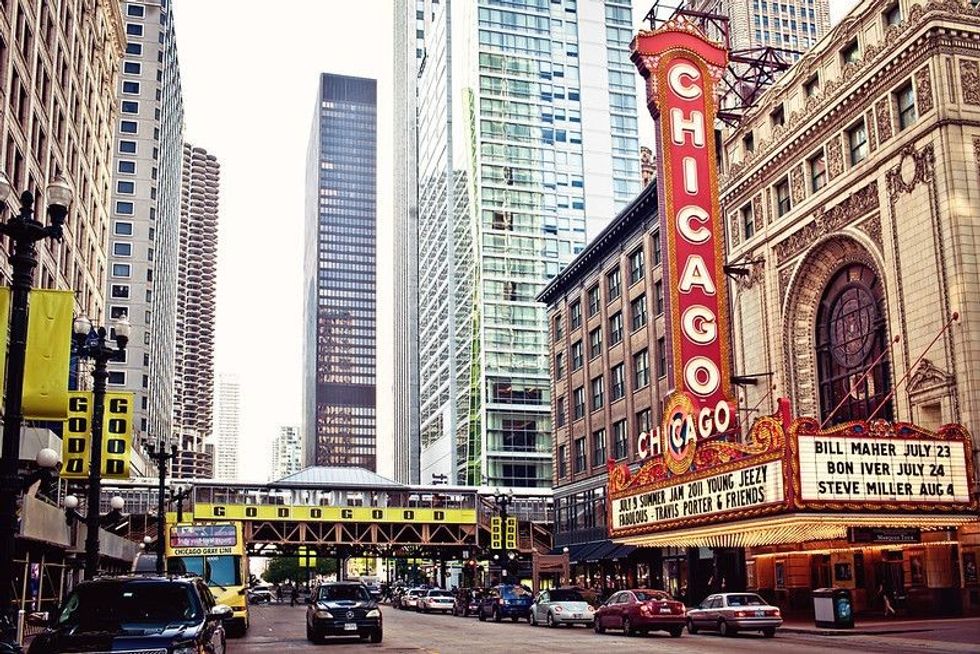Vikings And Anglo-Saxons Facts You Should Definitely Know!

Vikings and Anglo Saxons were two tribes of Germany that migrated to Europe in the middle ages.
Viking, also known as Norsemen, was an ancient tribe of seafaring warriors and pirates. In contrast to the barbaric nature of the Viking tribe, the Anglo-Saxons were a more civilized and cultural tribe of the early medieval period.
The Vikings originated mainly from three Scandinavian nations which are presently known as Norway, Denmark, and Sweden. This barbarian tribe existed from the latter half of the eighth century up to the late eleventh century.
The Vikings are still listed as one of the most furious fighters in history, they raided, traded, as well as pirated different parts of eastern and western Europe.
Starting from Scandinavia, the Viking raiders expanded their territory as far as the Middle East, North Africa, the Mediterranean coast, and North America.
The ruling period of the Vikings in the countries in which they settled after raiding is referred to as the Viking age. This tribe of warriors has an induced effect on the medieval history of Scandinavia as well as France, the British Isles, Kievan Rus, and Estonia.
The Anglo-Saxon period came into existence much before the Vikings but was much more reserved than the latter. The origin of the Anglo-Saxon period in Britain is traced back to the early fifth century.
The tribe migrated southwards at a time when the Roman rule in Britain faltered and a power vacuum was created.
As soon as the Roman power degraded and the Roman army failed to fight back, the Anglo-Saxon from northern Germany and southern Scandinavia started moving southwards and stretched their settlements up to southern Britain. These incomers to Britain actually settled around the coasts of the North Sea at first and started moving towards the mainland of Europe later.
Gradually, many natives began to adopt the culture and language of the Anglo Saxon and came under the Anglo Saxon realms.
This migrating culture established the kingdom of England and contributed 26% of their terminology to the modern English Language. This includes a vast majority of words that are used in our daily speech.
If you are interested to know more facts about the Vikings, then you can also check out the articles on Viking women facts and Vikings in Scotland facts.
Terminology And Names
The Vikings and Anglo-Saxons were two different tribes of the early middle ages. These two European tribes differed culturally from each other and they had different outlooks.
The meaning of the name Viking is uncertain. It is believed that it meant raiders or pirates.
The Anglo-Saxons regarded the Latin term wicing as synonymous with the Latin word pirata meaning pirates.
The name was not used to describe any nationality like the Northmen or the Danes. The Vikings were also known by some other names like the Germans called them Ascomani or ashmen since their boats were made of ash wood.
The Irish called them dubgail and finngail which meant dark and fair foreigners respectively.
The Gaels called them Lochlannaich meaning people from the land of lakes and the Anglo-Saxons referred to them as Dene or Dane. In old English, the name Viking came to be known as wicing for the first time in an Anglo-Saxon poem.
This poem dates back to the early ninth century and is generally referred to as the Scandinavian pirates.
The word Viking was introduced to the modern English language for the first time in the 18th century. At that time, heroic undertones of warriors and noble savages were used to describe the Vikings.
Later during the 20th century, the meaning of the term Viking was expanded, at that time historians realized that they were not only some sea raiders of Scandinavia and other northern lands but were actually people of a culture that produced pirates and seafarers from about 700 up to 1100.
Apart from describing the tribe, the name Viking is now also used as an adjective to refer to the period, artifacts, and ideas, that were connected to the culture of these people. In Eastern Europe, the name Viking was used to denote the concept of heroes.
The name Anglo-Saxon came from the Latin word Angli Saxones. This name was used to denote the people of a cultural group whom the English monk Bede named Angli around 730 and the British monk Gildas called Saxones in 530.
However, the Anglo-Saxons rarely used their popular name to refer to themselves, rather they were more comfortable with referring to themselves with tribal names like Cantie, Westseaxe, and Gewisse.
The Old English name Angil Saxones was first used in the writing of the eighth century. The name seemed to mean English Saxons in the piece of writing.
The name Angli was also present in old Christian literature, even Pope Gregory I mentions them in their story.
The name Anglo-Saxon was used later in titles around 924. The titles of the Anglo-Saxon literature glorified the Anglo-Saxon kings and it was deduced that probably the Anglo-Saxons were Christian people who were led by an Anglo-Saxon king appointed by the Christian God himself.
The Major Differences Between The Two
The Vikings and the Anglo-Saxons were two different European tribes who dominated the territories of the present United Kingdom in the early middle ages. Even though the Vikings and the Anglo-Saxons belonged to different eras, there were some notable similarities in them. However, some differences between the Viking and the Anglo-Saxon also exist.
England was a Roman town before the start of the fifth century, the Romans released their troops from England around 410. This created a power vacuum and numerous invaders from all sides began raiding this area.
The Anglo-Saxons were one such invader. The tribe arrived in southern England from present Denmark and settled in East Anglia.
England at that time was not a united nation and different tribes began invading different portions. Another German tribe called the Vikings came to England much later than Anglo-Saxon in the eighth century and settled in East Anglia.
This caused a conflict in interests. The Vikings emerged as a barbaric tribe of pirates who raided and invaded many parts of England between the ninth and the 11th century.
The Anglo-Saxons had to fight the Vikings to retain their power and were often forced to declare their power to the Danish kings. However, the Saxons led by the Anglo-Saxon king, king Alfred successfully repulsed the attack of the Vikings. They lived as neighbors in England but could never get along peacefully.
The Anglo-Saxon kings who became the successors of Alfred began to push the boundary of their territory. One by one all lands of the Vikings fell to the hands of Anglo-Saxon.
Anglo-Saxon began to conquer seven kingdoms. The Anglo-Saxon kingdoms came to be known as England and the Anglo-Saxon king came to be known as England's king.
In 1954, the last Viking king, Eric Bloodaxe was driven out by the Anglo-Saxon. The most powerful king of the Anglo-Saxon was king Edgar.
Viking Vs Anglo-Saxons Culture
Apart from the ruling territories and the vigor of the kings, there are also differences in culture between the Viking period and the Anglo-Saxon period. Saxons were much more civilized and reserved than the Vikings, they were more into farming and cultivating rather than the seafaring nature of the Vikings.
The Viking belief matched more with the Pagan religions while the nature of Anglo-Saxon appears similar to modern-day Christianity. The Viking and Anglo-Saxon art, religion, and ideas were all parts of the Viking and Anglo-Saxon cultures.
Normally the Vikings were seen as an unruly and barbaric tribe that plundered and burned the town of England down to the ground between the nine to eleventh centuries. This story is still written in the popular culture of history.
However, a lesser-known fact is that various sources illuminate the cultural, social, and religious diversity of the Vikings. Since the Danish armies of the Vikings began to capture England ruthlessly, they were described as a non-literate and barbaric cultural group.
However, even though they were illiterate, they had their own alphabets and communicate their words on runestones.
The 20th-century discoveries have given a more defined and balanced picture of the lives of the Vikings. They had rich and diversified archaeological structures that gave insights into the manufactured goods, crafts, trading networks, urban and rural settlement, as well as their religious beliefs.
According to the Anglo-Saxon chronicle, the Anglo-Saxons were described as a more culturally refined tribe than the Vikings. They were believed in Christianity.
They brought their own religions but the arrival of Saint Augustine in 597 converted most people to Christianity. The Anglo-Saxon built several other churches, the first fully Romanesque church of England, the Westminster Abbey was also built by them. The Shaftesbury Abbey is also one of the most well-known Anglo-Saxon artifacts, King Edwards's body was reburied at this place.
The Anglo-Saxons changed the architecture of Britain, they started building wooden artifacts in place of the stone buildings of the Romans. They spoke in their own language which gave rise to the present English language.
Theoretically, the Anglo-Saxons were more ethical and culturally educated than the Vikings but a deeper introspection in their culture suggests that the Anglo-Saxons were actually more barbaric than the Vikings. They unethically eradicated the native Britons from the Anglo-Saxon kingdoms.

Warfare Tactics
The Vikings and the Anglo Saxons, the former was a barbaric tribe of Germany while the latter was a more cultural tribe. Both of them carried on with their idea of conquering England during the middle ages. However, the warfare tactics of these two separate tribes were much different from each other.
The Vikings burned England down to ashes during the eleventh century. Their neighbors, the Anglo-Saxons somehow resisted the effects of their raids but could never actually coexist with them peacefully.
The violence of the Vikings was believed to be fuelled by their belief in Norse religion which focused on worshiping the God of war and death.
It is also believed that often the Vikings engaged in frenetic fighting within the community which was called 'berserkgang' and they were called 'berserker'.
This may have been a tactic of the shock troops that deployed men in berserk state intentionally. This type of frenetic action was probably induced through ingestion of materials that activated psychoactive properties in them like hallucinogens and large amounts of alcohol.
Before Alfred, the Anglo-Saxon armies fought in battles frequently, but the warfare tactic of the Anglo-Saxon became much more defensive during the reign of Alfred. Their wars were based on the possession of fortified places.
King Alfred was a worthy and intelligent leader of the Anglo-Saxons who along with the army troops succeeded in besieging them in fortified camps throughout the country.
The key motive of their warfare was seizing and controlling fortified places. This was mentioned clearly while describing the campaigns of 917 in the Anglo-Saxon chronicle.
At first, they dealt with the Vikings by probing ship crews but as their size and effect grew they started to deal with the Vikings by buying them off.
The Viking and the Anglo-Saxon England rule came to an end with the start of the Norman rule led by King William. Each conquest by Duke William of Normandy eradicated the Anglo-Saxon culture completely.
Anglo Saxon Vs Viking Influence Today
The Vikings and the Anglo Saxons left behind a permanent impact on the land, culture, and language of the European people even centuries after they raided the territories. Some of these impacts are still influencing the current world scenario.
The rise of feudalism in medieval Europe is traced back to the practice of the Vikings to build castles. They were the ones that influenced the creation of castles and barriers.
The Vikings were extraordinary builders, they started the concept of building forts and working in small groups. The modern cities and workplaces are built from these ideas of the Vikings and they resulted to be highly effective.
Similar to the Vikings, the Anglo-Saxons also have some legacies that are surviving still today, for example, the regional government of shires and hundreds of others. Christianity was also re-established properly in Europe during the Anglo-Saxon period by St. Augustine.
The Anglo-Saxon age gave flowering literature and contributed to the modern English language exceedingly. At present, 25-45% Anglo-Saxon ancestry is found in Britain while the Vikings have only 6% ancestry of the total Briton population.
Here at Kidadl, we have carefully created lots of interesting family-friendly facts for everyone to enjoy! If you liked our suggestions for Vikings and Anglo-Saxons facts, then why not take a look at Viking raid facts or Viking houses facts?
We Want Your Photos!
More for You
Bachelor of Science specializing in Computer Science

Christian MbaBachelor of Science specializing in Computer Science
Christian Mba is an experienced blogger and content writer with over a decade of experience. He holds a Bachelor of Science degree in Computer Science from Nigeria and has a keen interest in Python programming. Along with his writing and blogging expertise, he is also an SEO specialist with more than six years of experience. Chris, as he is commonly known, has a passion for music and enjoys playing the piano.
Disclaimer
1) Kidadl is independent and to make our service free to you the reader we are supported by advertising. We hope you love our recommendations for products and services! What we suggest is selected independently by the Kidadl team. If you purchase using the Buy Now button we may earn a small commission. This does not influence our choices. Prices are correct and items are available at the time the article was published but we cannot guarantee that on the time of reading. Please note that Kidadl is a participant in the Amazon Services LLC Associates Program, an affiliate advertising program designed to provide a means for sites to earn advertising fees by advertising and linking to Amazon. We also link to other websites, but are not responsible for their content.
2) At Kidadl, we strive to recommend the very best activities and events. We will always aim to give you accurate information at the date of publication - however, information does change, so it’s important you do your own research, double-check and make the decision that is right for your family. We recognise that not all activities and ideas are appropriate for all children and families or in all circumstances. Our recommended activities are based on age but these are a guide. We recommend that these ideas are used as inspiration, that ideas are undertaken with appropriate adult supervision, and that each adult uses their own discretion and knowledge of their children to consider the safety and suitability. Kidadl cannot accept liability for the execution of these ideas, and parental supervision is advised at all times, as safety is paramount. Anyone using the information provided by Kidadl does so at their own risk and we can not accept liability if things go wrong.
3) Because we are an educational resource, we have quotes and facts about a range of historical and modern figures. We do not endorse the actions of or rhetoric of all the people included in these collections, but we think they are important for growing minds to learn about under the guidance of parents or guardians.







